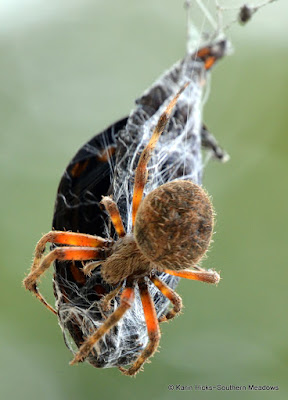Orb Weaver Spiders
Spiders. You either love them or hate them. I happen to be in the 'love' camp and it's a good thing because we have LOTS of spiders in our garden.
In late summer and early fall the orb weaver spiders have reached maturity and are on show with their masterfully designed webs hanging from all forms of plant life and structures. In fact its hard not to run into a spider web when trekking around our garden. Mating season is in full gear and these females need nourishment.
Orb weaver spiders build the classic web of concentric circles and spokes, which radiate outward from the center with anchor points. This genius design allows them to capture anything as small as a mosquito to as large as a butterfly. Other common meals include flies, thrips, mites, moths, beetles, wasps and bees. Evident by their diverse diet, they are not picky eaters and can have ferocious appetites. Their work helps keep insect populations in check and are a friend to this organic gardener.
Orb weaver spiders have poor vision and use vibration to know when they have captured prey. Watching a spider at work is incredibly fascinating. I happened to witness a butterfly mistakenly fly into a web and observed the spider quickly restrain its prey by wrapping it in silk. This is done so that the web will not be destroyed by the movement of prey trying to escape the sticky webbing.
Here is the series of shots I took over a period of a few minutes.
Once the prey is crushed the spider will consume the liquids in the insect's body. Below is another spotted orb weaver, found hanging across our back driveway, this time with a gulf fritillary butterfly.
I accidentally disturbed her web as I walked by and she instinctively began to pull
up her meal to a secure location in the oak tree branches she was using as her anchor. This species usually takes down its web each day by eating it, recycling the proteins contained in the web, and creates a fresh web in the evening.
Unlike most orb weavers that have a bulbous abdomen, the Arrowhead is distinctive with its big yellow arrowhead shaped body and marking. This smaller spider, at half an inch long, is also unusual because it hangs with its head facing up, where most spiders hang head down.
The arrowhead spider prefers to build its web in forests and shadier areas of the garden and is notorious for building webs across paths at eye level.
Spiders are peaceful dwellers in the garden. It's unfortunate that so many have an irrational fear of these beneficial creatures.
disclaimer: as an avid butterfly gardener it does make my heart sad when I see them captured; however, we have created a habitat garden and I have made peace with the fact that all insects have to eat. It's all part of a functioning, balanced ecosystem.
In late summer and early fall the orb weaver spiders have reached maturity and are on show with their masterfully designed webs hanging from all forms of plant life and structures. In fact its hard not to run into a spider web when trekking around our garden. Mating season is in full gear and these females need nourishment.
 |
| Black & Yellow Argiope (female) |
Orb weaver spiders build the classic web of concentric circles and spokes, which radiate outward from the center with anchor points. This genius design allows them to capture anything as small as a mosquito to as large as a butterfly. Other common meals include flies, thrips, mites, moths, beetles, wasps and bees. Evident by their diverse diet, they are not picky eaters and can have ferocious appetites. Their work helps keep insect populations in check and are a friend to this organic gardener.
Orb weaver spiders have poor vision and use vibration to know when they have captured prey. Watching a spider at work is incredibly fascinating. I happened to witness a butterfly mistakenly fly into a web and observed the spider quickly restrain its prey by wrapping it in silk. This is done so that the web will not be destroyed by the movement of prey trying to escape the sticky webbing.
Here is the series of shots I took over a period of a few minutes.
 |
| Spotted orb weaver (female) |
Once the prey is crushed the spider will consume the liquids in the insect's body. Below is another spotted orb weaver, found hanging across our back driveway, this time with a gulf fritillary butterfly.
 |
| Spotted orb weaver (female) |
Unlike most orb weavers that have a bulbous abdomen, the Arrowhead is distinctive with its big yellow arrowhead shaped body and marking. This smaller spider, at half an inch long, is also unusual because it hangs with its head facing up, where most spiders hang head down.
 |
| Arrowhead orb weaver |
The arrowhead spider prefers to build its web in forests and shadier areas of the garden and is notorious for building webs across paths at eye level.
Spiders are peaceful dwellers in the garden. It's unfortunate that so many have an irrational fear of these beneficial creatures.
disclaimer: as an avid butterfly gardener it does make my heart sad when I see them captured; however, we have created a habitat garden and I have made peace with the fact that all insects have to eat. It's all part of a functioning, balanced ecosystem.









.png)
